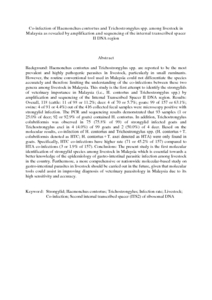Citation
Tan, Tiong Kai and Panchadcharam, Chandrawathani and Low, Van Lun and Lee, Soo Ching and Ngui, Romano and Sharma, Reuben Sunil Kumar and Lim, Yvonne Ai Lian
(2014)
Co-infection of Haemonchus contortus and Trichostrongylus spp. among livestock in Malaysia as revealed by amplification and sequencing of the internal transcribed spacer II DNA region.
BMC Veterinary Research, 10 (38).
pp. 1-7.
ISSN 1746-6148
Abstract
Background: Haemonchus contortus and Trichostrongylus spp. are reported to be the most prevalent and highly pathogenic parasites in livestock, particularly in small ruminants. However, the routine conventional tool used in Malaysia could not differentiate the species accurately and therefore limiting the understanding of the co-infections between these two genera among livestock in Malaysia. This study is the first attempt to identify the strongylids of veterinary importance in Malaysia (i.e., H. contortus and Trichostrongylus spp.) by amplification and sequencing of the Internal Transcribed Spacer II DNA region. Results: Overall, 118 (cattle: 11 of 98 or 11.2%; deer: 4 of 70 or 5.7%; goats: 99 of 157 or 63.1%; swine: 4 of 91 or 4.4%) out of the 416 collected fecal samples were microscopy positive with strongylid infection. The PCR and sequencing results demonstrated that 93 samples (1 or 25.0% of deer; 92 or 92.9% of goats) contained H. contortus. In addition, Trichostrongylus colubriformis was observed in 75 (75.8% of 99) of strongylid infected goats and Trichostrongylus axei in 4 (4.0%) of 99 goats and 2 (50.0%) of 4 deer. Based on the molecular results, co-infection of H. contortus and Trichostrongylus spp. (H. contortus + T. colubriformis denoted as HTC; H. contortus + T. axei denoted as HTA) were only found in goats. Specifically, HTC co-infections have higher rate (71 or 45.2% of 157) compared to HTA co-infections (3 or 1.9% of 157). Conclusions: The present study is the first molecular identification of strongylid species among livestock in Malaysia which is essential towards a better knowledge of the epidemiology of gastro-intestinal parasitic infection among livestock in the country. Furthermore, a more comprehensive or nationwide molecular-based study on gastro-intestinal parasites in livestock should be carried out in the future, given that molecular tools could assist in improving diagnosis of veterinary parasitology in Malaysia due to its high sensitivity and accuracy.
Download File
![[img]](http://psasir.upm.edu.my/36804/1.hassmallThumbnailVersion/Co-infection%20of%20Haemonchus%20contortus%20and%20Trichostrongylus%20spp.%20among%20livestock%20in%20Malaysia%20as%20revealed%20by%20amplification%20and%20sequencing%20of%20the%20internal%20transcribed%20spacer%20II%20DNA%20region.pdf)  Preview |
|
PDF (Abstract)
Co-infection of Haemonchus contortus and Trichostrongylus spp. among livestock in Malaysia as revealed by amplification and sequencing of the internal transcribed spacer II DNA region.pdf
Download (152kB)
| Preview
|
|
Additional Metadata
Actions (login required)
 |
View Item |

